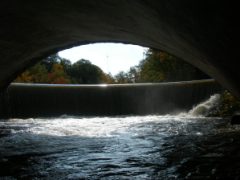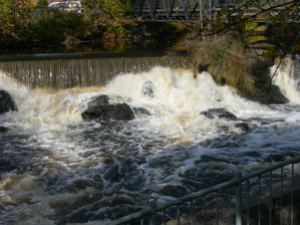 I launched the new red double kayak from Nahanton Park in Newton. The Boy was in the front seat and The Girl was in a jump seat plopped between my feet.
I launched the new red double kayak from Nahanton Park in Newton. The Boy was in the front seat and The Girl was in a jump seat plopped between my feet.
Nahanton Park is one of the newer locations of Charles River Canoe and Kayak. It is a less visible location than it’s main location next to the Marriott, but it’s a much nicer stretch of the river. There is plenty of parking and a dock at the park which makes the launch very easy.
The Needham radio and television towers are visible in the distance once you enter this section of the river. There are significant industrial buildings along the river. If you remember your history of the industrial revolution in the northeast, this means there are dams along the river. There are three portages ahead, sure to be a challenge in the big new kayak.
 There is a modern railroad bridge abutting older stone abutments which mark the location of an older bridge. This bridge was for the Charles River branch of the Boston and Worcester Railroad. Built in 1850, this rail line was built to bring stone and gravel from Needham to fill Boston’s Back Bay. During its peak, forty car trains of fill ran every 45 minutes.
There is a modern railroad bridge abutting older stone abutments which mark the location of an older bridge. This bridge was for the Charles River branch of the Boston and Worcester Railroad. Built in 1850, this rail line was built to bring stone and gravel from Needham to fill Boston’s Back Bay. During its peak, forty car trains of fill ran every 45 minutes.
The Elliot Street Bridge is made of three stone arches and appears just before the Silk Mill Dam. There are new signs warning of the approaching dam. You can see the river disappear and hear an increasing roar as you pass under the bridge.
There is a good spot to take the kayak out of the river and start the portage. It was fairly long walk of about 300 yards through Hemlock Gorge Reservation, leading down into Hemlock Gorge between Newton’s Upper Falls and the Echo Bridge. With the weight of the new kayak on my back, I realized I needed to get some wheels for the portages.
Halfway down the portage, there is a great spot atop the rock of the gorge. The old mill building is across the river and you can feel the force of the water poring over the dam.
The fall of water at Hemlock Gorge was an attractive power supply for industry. In 1688 John Clark built a sawmill. His sons expanded by adding a fulling mill and a grist mill. In 1788 Simon Elliot bought part of the site and put in a snuff mill. In 1824 a cotton mill was added, which was later converted to a silk mill. The dam is often called the Silk Mill Dam because of this long running use of the dam.

Just downstream of the Silk Mill Dam is Echo Bridge. It is famous for the wonderful echoes that can resonate back and forth between the arches. Yes, we all hollered out as we went under. The echo was very impressive.

Echo Bridge carries the Sudbury Aqueduct. In 1878, the mainstream of the Sudbury River was diverted via the Sudbury Aqueduct to the Chestnut Hill Reservoir to supply water for the City of Boston. The bridge was built in 1876, spanning 130 feet across the Charles River.

Next on the river was the Circular Dam or Horseshoe Dam. The dam was not marked and it was harder to hear because it was right next to the overpass for Route 9.
This is also the site of a portage under Route 9 on the Ellis Street underpass, down to Turtle Island. A millrace was put in place here in 1782 for a sawmill. In 1792 Newton Iron Works took over and rolled iron bars for 50 years. The millrace is to the right of the dam and is the landing spot for the portage. There is a new spillway put in place that makes the bank a bit more steep and the exit a bit harder.

The Charles then follows Route 128/ Interstate 95 for a few miles. The road signs on Route 128 are visible from the river. The right bank of the river in this section follows Quinobequin Road in Newton. The left bank has relatively new sound barriers along 128 that greatly reduce the traffic noise. Vegetation has grown along the walls, but they still look massive and tower above the river.
After passing under Route 128, we passed under the Cochituate Aqueduct crossing the river and under 128 on a three-arched bridge. The Cochituate Aqueduct was built in 1848 to carry water from Lake Cochituate in Framingham to the Chestnut Hill Reservoir. It serves a similar purpose to the Sudbury Aqueduct that runs through Echo Bridge.

Just below Water Street in Wellesley is the Cordingly Dam. The last time I was here I entered the river to early and floated through the rapids unsuccessfully, leaving me flapping in the river like one of the herring in the dam’s fish ladder. Since I had the kids I was not going to risk tipping the kayak, so we took a much longer portage downstream.
We ended this stretch of the river at Washington Street / Route 16 in Wellesley at the top of Newton Lower Falls.

You can the rest of my paddling trips laid out on a map: Paddling Trips.
View Paddling Trips in a larger map


One thought on “Paddling with the Kids in Hemlock Gorge”
Comments are closed.